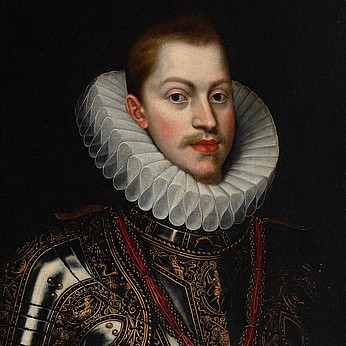Attributed to AGUSTÍN ESTEVE Y MÁRQUES (Valencia, 1753 - 1820). "Portrait of a clergyman. It has slight flaws in the painting.
Lot 64
About Seller
Setdart Auction House
Carrer Aragó 346
Barcelona
Spain
Setdart Subastas was born in 2004 and is currently the first online art auction in Spain with solidity, prestige and reliability guaranteed by our more than 60,000 users. Setdart has a young, dynamic and enterprising team ready to successfully manage the purchase and sale of art works through custom...Read more
Estimate:
EUR€7,000 - EUR€8,000
$7,526.88 - $8,602.15
Absentee vs Live bid
Two ways to bid:
- Leave a max absentee bid and the platform will bid on your behalf up to your maximum bid during the live auction.
- Bid live during the auction and your bids will be submitted real-time to the auctioneer.
Bid Increments
| Price | Bid Increment |
|---|---|
| EUR€0 | EUR€10 |
| EUR€200 | EUR€25 |
| EUR€500 | EUR€50 |
| EUR€1,000 | EUR€100 |
| EUR€3,000 | EUR€200 |
| EUR€5,000 | EUR€500 |
| EUR€10,000 | EUR€1,000 |
| EUR€20,000 | EUR€2,000 |
| EUR€50,000 | EUR€5,000 |
About Auction
By Setdart Auction House
Nov 24, 2021
Set Reminder
2021-11-24 09:00:00
2021-11-24 09:00:00
America/New_York
Bidsquare
Bidsquare : Old Masters, Day 1
https://www.bidsquare.com/auctions/setdart-auction-house/old-masters-day-1-7873
Setdart Auction House sofia@setdart.com
Setdart Auction House sofia@setdart.com
- Lot Description
Attributed to AGUSTÍN ESTEVE Y MÁRQUES (Valencia, 1753 - 1820). "Portrait of a clergyman. It has slight flaws in the painting. It has an inscription on the back about the property (Antonio Castellano, son). Measurements: 59 x 44 cm. Due to the formal and stylistic characteristics of the piece, we are in front of a painting that follows the style of the artist Agustín Esteve y Marqués. The canvas represents the portrait of a soberly attired gentleman of whom we do not appreciate any more remarkable trace than face. A face that sketches a slight smile, thus conveying a certain closeness and complicity with the viewer. The portrait genre began to proliferate in the eighteenth century, especially in the nineteenth century, when the upper classes of the bourgeoisie and nobility began to commission portraits, often with symbolic components, such as books or other objects that could give the image they wished to project. Agustín Esteve stood out mainly for the innumerable portraits he painted of Court nobles and high court bureaucrats. Under the protection of Godoy and the Osuna and Alba families, the painter developed a successful career at court until 1808. As in the case of other artists of his generation, the French invasion of 1808 and the convulsive period that lasted until 1814, together with the appearance of new painters and the natural decline of his age, caused his star to be eclipsed by minor commissions after the restoration of Ferdinand in 1814 and, at the end of his life, he even struggled financially. Born into a family of artists, Agustín Esteve received his first lessons from his father, the sculptor Antonio Esteve. He then entered the Academy of Fine Arts of San Carlos in Valencia, and from there he went to the Academy of San Fernando in Madrid, where in 1773 he was awarded for the first time, with a third class prize in the annual competition of the Academy. After completing this final stage of his training, in which the influence of Mengs' teaching can be observed, Esteve became Francisco de Goya's assistant, something that would profoundly mark the Valencian artist's work from then on. The activity at Goya's side must have been intense since 1780, since after the death of Carlos III the new king commissioned the Aragonese painter numerous portraits for different institutions, many of which were made directly by Esteve based on Goya's originals. During these years the painter would begin his good relations with the court, becoming the official portraitist first of the house of Osuna, and finally the main portraitist of the court at the end of the 18th century. Thus, Goya's patronage and Esteve's intense portraitist activity were finally rewarded when he was appointed Pintor de Cámara in 1800. With the entry of the French into Madrid and the accession of Joseph I to the throne, Agustín Esteve faced the same dilemma as the rest of the Pintores de Cámara regarding his loyalty to the new sovereign. Esteve, like the rest, placed himself under the orders of the new king and received his salaries as a painter of the Chamber. In spite of this, on the return of Ferdinand VII he had no problems to rejoin the service of his former master, since he was not in favor of Napoleon's brother. However, by 1814, at the age of sixty-one, Agustín Esteve's physical decrepitude was evident, his best days were over. And even more so considering that Goya's exile and the rise of Vicente López would corner him among the Chamber painters, although he continued to carry out some important commissions. Esteve is currently represented in the Prado Museum and the Museum of Fine Arts of Valencia, among other important institutions and private collections.
- Shipping Info
-
In-house shipping available. Please inquire at admin@setdart.com.
-
- Buyer's Premium



 EUR
EUR CAD
CAD AUD
AUD GBP
GBP MXN
MXN HKD
HKD CNY
CNY MYR
MYR SEK
SEK SGD
SGD CHF
CHF THB
THB














